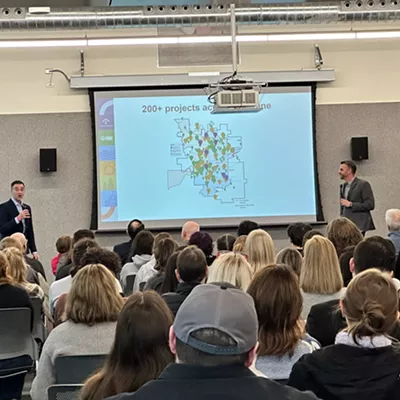Friday, September 23, 2016
Spokane Public Schools recognized for improving equality in AP courses
For years, minority groups have been underrepresented in Advanced Placement classrooms across the country. Even though black and Latino students make up 37 percent of students in high schools in the U.S., only 27 percent enrolled in AP courses that offer college-level curricula, and only 18 percent passed an AP exam, according to the U.S. Department of Education.
Over the last five to six years, Spokane Public Schools has made an effort to get more students to take more rigorous coursework. In the process, says Chief Academic Officer Steven Gering, the district has discovered that sometimes the reason students don't take higher-level coursework is simple: they don't think they can. Or they don't know what they'd be getting into.
"Some of it was kids saying, 'If somebody encouraged me, I would do it,'" Gering says.
So Spokane Public Schools has made an effort to do just that, and they're seeing it make a difference. The U.S. Department of Education recognized Spokane Public Schools this week as one of the first districts in the nation to commit to including students of all backgrounds in AP courses, which many colleges see as evidence that applicants can challenge themselves academically. That puts them on a list of 117 districts who are now part of the Lead Higher Initiative through Equal Opportunity Schools, an effort to identify 100,000 "low-income students and students of color" ready for AP courses by fall 2017.
This follows another recognition last year, in which SPS was named one of 130 districts in the country named to the Gaston Caperton Opportunity Honor Roll for "excelling in creating opportunities for traditionally underrepresented students." Four other districts in the state were also on the Gaston Caperton list: Bickleton, Renton, Tacoma and Tukwila.
Gering says this all started as an effort to make diversity in AP classes more reflective of the student body as a whole. In the last several years, the district has been actively recruiting families to take AP courses — by having staff members identify students who could benefit and by surveying kids.
"Lots of times kids are as qualified, or more qualified, than kids already in AP courses and they just don't know it," Gering says.
Rogers High School, as we wrote about earlier this year, is planning for all of this year's freshmen to take AP English in their junior year, as part of a grant from College Spark Washington.
While Spokane Public Schools has been recognized for its success, Gering says there's more work to be done. The district is looking beyond AP classes at how to get underrepresented students into honors classes in earlier grades.
In Washington state, participation in AP courses has become more diverse in the last decade-plus. According to a report by the College Board, the percentage of low-income students and Hispanic students in AP classes has increased, while the percentage of white students has decreased. But the percentage of black and Native American students has stayed about the same.
Gering says he wants to be careful in saying the district's high schools have successfully closed the gap for diversity in AP courses. He says one high school closed the gap a couple years ago, then the following year it came back.
"It's an ongoing issue," Gering says. "We've made a lot of gains, but we still have some gaps we're working on."
Tags: Spokane Public Schools , Advanced Placement , News , Image
















